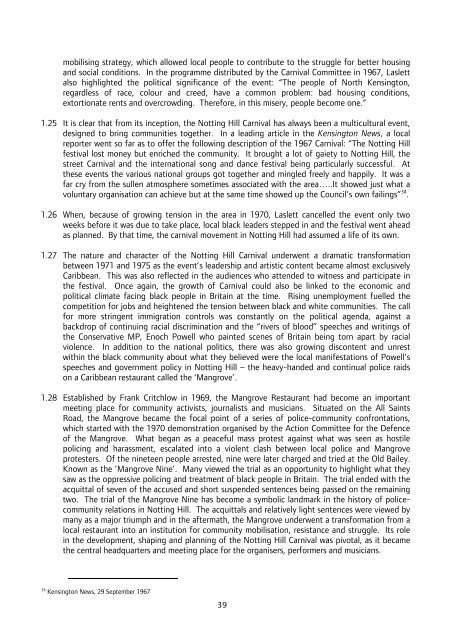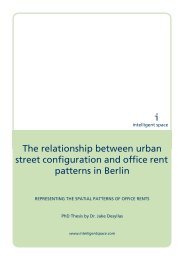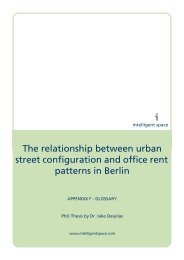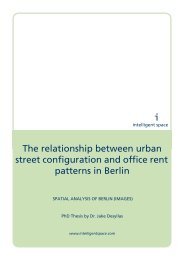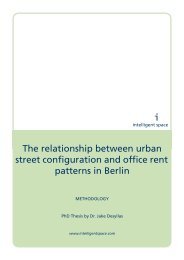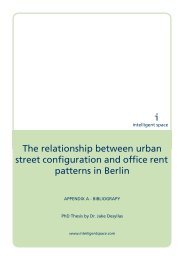Notting Hill Carnival Strategic Review - Intelligent Space
Notting Hill Carnival Strategic Review - Intelligent Space
Notting Hill Carnival Strategic Review - Intelligent Space
Create successful ePaper yourself
Turn your PDF publications into a flip-book with our unique Google optimized e-Paper software.
mobilising strategy, which allowed local people to contribute to the struggle for better housing<br />
and social conditions. In the programme distributed by the <strong>Carnival</strong> Committee in 1967, Laslett<br />
also highlighted the political significance of the event: “The people of North Kensington,<br />
regardless of race, colour and creed, have a common problem: bad housing conditions,<br />
extortionate rents and overcrowding. Therefore, in this misery, people become one.”<br />
1.25 It is clear that from its inception, the <strong>Notting</strong> <strong>Hill</strong> <strong>Carnival</strong> has always been a multicultural event,<br />
designed to bring communities together. In a leading article in the Kensington News, a local<br />
reporter went so far as to offer the following description of the 1967 <strong>Carnival</strong>: “The <strong>Notting</strong> <strong>Hill</strong><br />
festival lost money but enriched the community. It brought a lot of gaiety to <strong>Notting</strong> <strong>Hill</strong>, the<br />
street <strong>Carnival</strong> and the international song and dance festival being particularly successful. At<br />
these events the various national groups got together and mingled freely and happily. It was a<br />
far cry from the sullen atmosphere sometimes associated with the area…..It showed just what a<br />
voluntary organisation can achieve but at the same time showed up the Council’s own failings” 34 .<br />
1.26 When, because of growing tension in the area in 1970, Laslett cancelled the event only two<br />
weeks before it was due to take place, local black leaders stepped in and the festival went ahead<br />
as planned. By that time, the carnival movement in <strong>Notting</strong> <strong>Hill</strong> had assumed a life of its own.<br />
1.27 The nature and character of the <strong>Notting</strong> <strong>Hill</strong> <strong>Carnival</strong> underwent a dramatic transformation<br />
between 1971 and 1975 as the event’s leadership and artistic content became almost exclusively<br />
Caribbean. This was also reflected in the audiences who attended to witness and participate in<br />
the festival. Once again, the growth of <strong>Carnival</strong> could also be linked to the economic and<br />
political climate facing black people in Britain at the time. Rising unemployment fuelled the<br />
competition for jobs and heightened the tension between black and white communities. The call<br />
for more stringent immigration controls was constantly on the political agenda, against a<br />
backdrop of continuing racial discrimination and the “rivers of blood” speeches and writings of<br />
the Conservative MP, Enoch Powell who painted scenes of Britain being torn apart by racial<br />
violence. In addition to the national politics, there was also growing discontent and unrest<br />
within the black community about what they believed were the local manifestations of Powell’s<br />
speeches and government policy in <strong>Notting</strong> <strong>Hill</strong> – the heavy-handed and continual police raids<br />
on a Caribbean restaurant called the ‘Mangrove’.<br />
1.28 Established by Frank Critchlow in 1969, the Mangrove Restaurant had become an important<br />
meeting place for community activists, journalists and musicians. Situated on the All Saints<br />
Road, the Mangrove became the focal point of a series of police-community confrontations,<br />
which started with the 1970 demonstration organised by the Action Committee for the Defence<br />
of the Mangrove. What began as a peaceful mass protest against what was seen as hostile<br />
policing and harassment, escalated into a violent clash between local police and Mangrove<br />
protesters. Of the nineteen people arrested, nine were later charged and tried at the Old Bailey.<br />
Known as the ’Mangrove Nine’. Many viewed the trial as an opportunity to highlight what they<br />
saw as the oppressive policing and treatment of black people in Britain. The trial ended with the<br />
acquittal of seven of the accused and short suspended sentences being passed on the remaining<br />
two. The trial of the Mangrove Nine has become a symbolic landmark in the history of policecommunity<br />
relations in <strong>Notting</strong> <strong>Hill</strong>. The acquittals and relatively light sentences were viewed by<br />
many as a major triumph and in the aftermath, the Mangrove underwent a transformation from a<br />
local restaurant into an institution for community mobilisation, resistance and struggle. Its role<br />
in the development, shaping and planning of the <strong>Notting</strong> <strong>Hill</strong> <strong>Carnival</strong> was pivotal, as it became<br />
the central headquarters and meeting place for the organisers, performers and musicians.<br />
34<br />
Kensington News, 29 September 1967<br />
39


